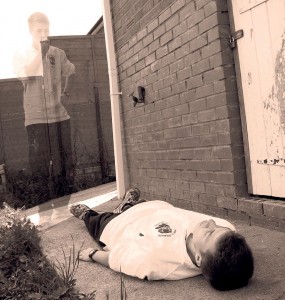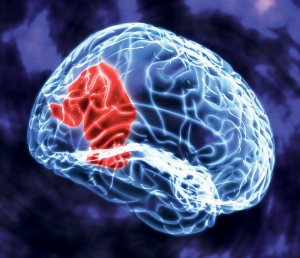SUNDAY, 7 NOVEMBER 2010
 Out of body experiences are generally considered to be simple illusions, created in the mind. But is there a scientific explanation for this phenomenon? Why do so many different individuals have such similar experiences?
Out of body experiences are generally considered to be simple illusions, created in the mind. But is there a scientific explanation for this phenomenon? Why do so many different individuals have such similar experiences?Out of body experiences crop up in highly diverse contexts, from religious gatherings to hallucinogenic trips. There are numerous reports of out of body experiences from people undergoing a general anaesthetic, and over five per cent of epileptics, at some point in their life, have a perception of leaving their body.
The occurrence of out of body experiences might appear to support the view that mind and body are separate. It seems intuitive that the ‘I’ that causes your knees to bend is in control of, yet distinct from, the body of which those knees are a part. This division of mind and body is an old Aristotelian throwback, in which the mind is seen as a ‘ghost’ in the physical machine. If the mind is indeed separate, then it is conceivable (even if conceptually difficult to imagine) that out of body experiences could be due to the mind’s dissociation from the physical body.
This view has, however, been challenged over the past few decades as we have started to understand the neuronal basis of our sensory perceptions and thought processes. It seems that the mind is in fact equivalent to the brain. If this is so, then the mind cannot by definition become displaced from its physical location. Instead, we have come to recognise out of body experiences as derangements in perception, in which the location of ‘self’ has been mapped or processed incorrectly. So what mechanism underlies our perception of self? Furthermore, what causes it to malfunction?
With any sensory perception, we are used to considering the inputs, the neuronal interactions and then finally the resulting sensory read-out. One example of sensory perception is taste: the input is the activation of taste receptors, neuronal interactions process these inputs, and the output is our perception of flavour. We can view perception of self in a similar manner. Faults at any location in this information flow could be responsible for out of body experiences.
To demonstrate that neuronal interactions underlie our localisation of self, we can start by attempting to identify the region of the brain involved. To this end, various neurological and psychiatric patients have been studied. In these patients, specific brain lesions result in distinct clinical presentations that relate directly to the area of brain that is damaged. Therefore, identifying the damaged area in patients who have had out of body experiences should lead us to the region necessary for this perception. Although the temporal lobe has long been implicated in the perception of out of body experiences, modern imaging techniques have identified the right temporo-parietal junction as the critical locus for self-perception. This region, found just behind the ear on the right-hand side, is important for integrating various senses.
In order to demonstrate that the temporo-parietal junction is indeed responsible, some researchers have set out to artificially induce out of body experiences by directly stimulating the region. A Belgian research team was one of the first to succeed. Using electrodes originally inserted for the treatment of tinnitus, they were able to cause their 60-year-old patient to feel as though he were “floating outside his body”. Many successes using subdural electrodes to stimulate the same region have followed. The fact that stimulation of this specific area of the brain consistently results in similar perceptions provides strong evidence that this is the vital area that malfunctions during out of body experiences.
In addition to epileptics and those with brain lesions, out of body experiences are known to occur occasionally in people with sleep paralysis and Guillain-Barré syndrome (a peripheral nerve disorder). Also, people under anaesthesia and chronic users of cannabis have reported out of body experiences. It is possible that, alongside their diagnosed condition, these patients have damage to the temporo-parietal region that causes their out of body experiences, although it seems more likely that the necessary inputs to the right temporo-parietal junction are just being interrupted.
The similarity of people’s experiences is another line of evidence that supports the existence of a distinct and localised mechanism of self-perception. Reports of out of body experiences are remarkably similar, with people predominantly describing floating above their bodies at a distance of one or two metres. This commonality of experience seems logical if we are dealing with similar interruptions to a specific pathway.
So we can show that there is probably a distinct brain region involved in out of body experiences, but how is it that an incorrect input or a fault in processing can result in such a precise relocation of the self to an alternate location? An answer to this question may be found by drawing a parallel between out of body experiences and phantom limbs. Phantom limbs are a rare phenomenon in which amputees perceive their lost limbs as still being present. In many cases, they also feel that the limb still moves or causes them pain. It has been suggested that these cases are due to damaged nerves generating abnormally strong or accidentally cohesive inputs, so that the brain misinterprets the limb as being present. This concept is transferable to out of body experiences, with the generation of an alternate self being considered equivalent to that of the phantom limb. However, it does not entirely explain the phenomenon, as phantom limbs are perceived in appropriate locations while the alternate self is perceived as being displaced to a new location. It has been suggested by some groups that this is due to the involvement of the vestibular system, on which our body normally depends for balance.
There are still many gaps in our understanding, such as why so many people report feeling ‘a presence’ while disembodied, or intuitively associate the occurrence with religion. Not to mention what quirk in our psychology means that we intuitively accept disembodiment as plausible. There is, however, an ever-increasing body of evidence that seems to confirm that out of body experiences are errors in perception, not true dissociations of mind from matter.
Celia St John-Green is a medical student in the School of Clinical Medicine

